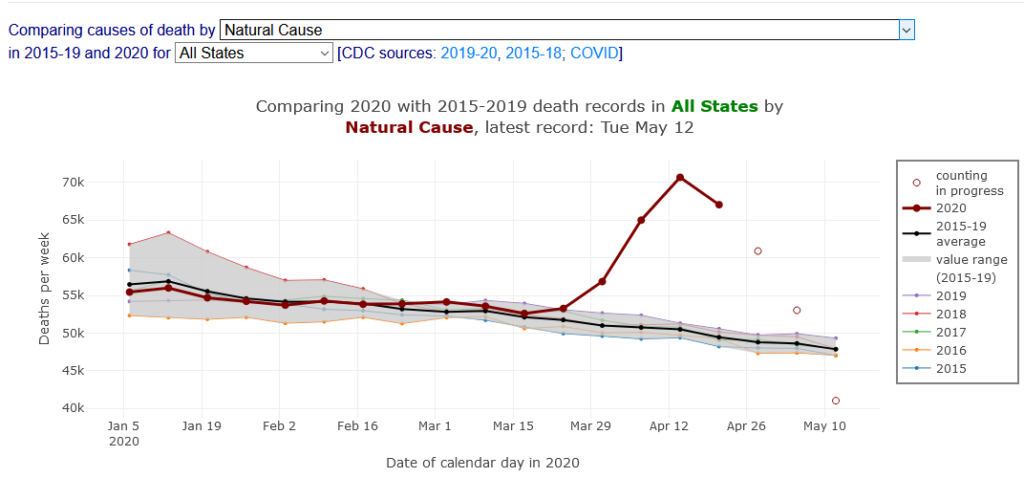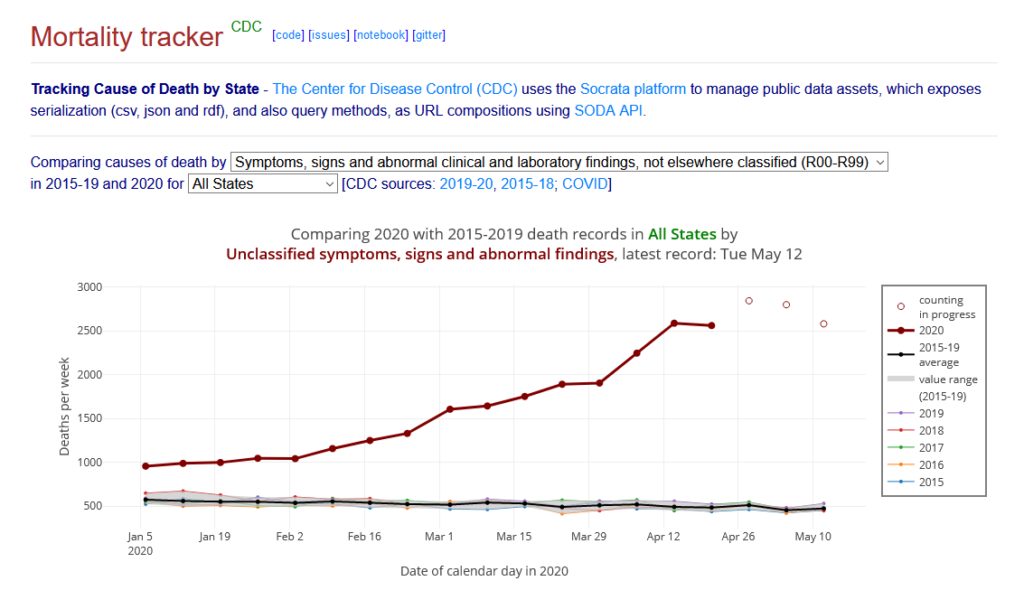Pneumonia kills about 50,000 Americans every year, according to the CDC. This year, over 90,000 people have succumbed to the disease between February and late May.
The evolution of the disease this year, however, doesn’t follow the normal trend. Typically, pneumonia comes after the flu season: starting in December, peaking in January, and then declining in March and April. But this year, spikes in the number of pneumonia cases have been reported in several US states following the evolution of the coronavirus outbreak — suggesting that the total tally of COVID-19 may be severely underestimated.

Extra deaths
While we’re now several months into this pandemic, we’re still struggling to make sense of this virus in many ways. Case in point: we still don’t know how many people the virus has killed.
The world is still debating exactly what constitutes a COVID-19 death.
When someone is relatively healthy beforehand and is killed following infection with the coronavirus, the case is pretty clear-cut. But what if someone had a pre-existing condition? The virus obviously played a role in this scenario, but there is still debate on where exactly to draw the line — was it responsible for the patient’s death in this case, or not?
Add in a shortage of tests and the fact that many elderly who succumb aren’t tested at all, and you start to understand why the general picture is so unclear.
In many places, there has been a surge of extra deaths (compared to the baseline mortality values) and officially, COVID-19 only accounts for a part of them. Take the state of Maryland, for instance. It has been fairly quiet in terms of coronavirus outbreak, with under 50,000 cases (remember when 50,000 cases used to be considered a lot?). The state, however, recorded a greater number of deaths than in previous years. When you compare this year’s numbers with those from previous years, you end up with a compelling picture.
Slight statistical variations in the numbers of deaths throughout the year are perfectly normal — sometimes, they dip below the expected value, and sometimes there’s an excess. However, in this case, the excess in deaths correlates very well with COVID-19 figures.
A similar trend has been observed in several other states.
In the figures above, we see the total number of excess deaths. Many of those, however, are not recorded as COVID-19 deaths.
Note that at the same time as COVID-19 fatalities start appearing in the records, the number of deaths not attributed to COVID-19 also surges. This is extremely unlikely to be a coincidence. It’s far likelier that these are cases that have simply been misdiagnosed and are flying under the radar.
This trend is noticeable in other states, indicating that a large part of the damage done by COVID-19 is not officially recorded.
Instead, many places record this excess as pneumonia.
Pneumonia and COVID-19
The current evolution of pneumonia we’re seeing in the US can only be explained by COVID-19.
In Kentucky, spiking pneumonia deaths are increasingly linked with COVID-19. These deaths aren’t classed as COVID-19, although experts are certain that this is the culprit.
“I think clearly there are cases that are not getting counted as COVID deaths,” said Dr. Derek Forster, medical director for infection prevention and control at UK HealthCare for USA Today. “How much of that is completely COVID-19, I don’t know. But I do think there are more deaths than accounted for in the testing numbers.”
The number of pneumonia victims has climbed through April and May, which is not what normally happens — this has never happened on this scale in the modern history of the US.
In fact, when you compare this year’s pneumonia cases with the average over the past years, there is a stark difference. Quite likely, that difference can be explained by an undetected number of COVID-19 cases.
“The pneumonia we’re seeing from COVID is one of the worst pneumonias we’ve seen in the last several years,” said Dr. Bashar Alhariri, medical director of the intensive care unit at Norton Healthcare’s downtown campus.. “It’s very difficult and tricky to treat.”
Even when cases are tested, detection is not guaranteed. Alhariri is one of the many doctors who have reported that they’ve had patients whose tests came back negative, only for an antibody or fecal test to come back positive.
Hidden in multiple categories
It’s not just pneumonia, either. There is another strong indicator showing that many COVID-19 deaths go undetected: the number of deaths from “natural causes” is surging across the entire country.

Other categories of cases are also rising. For instance, an unprecedented number of people are turning up with ‘abnormal symptoms’ — and again, there is a good correlation with the coronavirus outbreak here. It is very likely that many of those abnormal symptoms are caused COVID-19.

Over the past couple of months, it has become increasingly clear that oftentimes, COVID-19 cases don’t get classed as such. It’s hard to find all the cases, but ignoring this could lull people into a false sense of security.
If we only look at the COVID-19 charts, we’re missing an important part of the story, because that data doesn’t record everything. As a corollary, just because that chart is going down doesn’t necessarily mean that the entire situation is improving.
Data manipulation
Lastly, the fact that many COVID-19 fatalities are hidden in other data should be considered when deciding how to reopen the states. Because the data is complex and not always clear, it can be very easily misrepresented or manipulated.
In Russia, a surge of ‘mysterious pneumonia’ ravaged the capital even before any significant COVID-19 transmission was officially declared. Russia either ignored or tried to hide its COVID-19 cases by masking them with pneumonia. Now, Russia is the 3rd most-affected country.
It goes to show that these hidden cases can and do get ignored, whether through carelessness or willful ignorance.
In many US states, anti-lockdown protests have claimed that the virus isn’t that dangerous, a view that is shared by some high-ranking officials, notably, Florida Governor Ron DeSantis. DeSantis recently fired Rebekah Jones, who created and oversaw a data portal that for months has provided easily accessible and detailed information on COVID-19 cases broken down by ZIP code. The portal has been praised by researchers in the state and by Dr. Deborah Birx, the White House’s coronavirus task force coordinator.
But Jones was fired and says it was because she refused to manipulate data to support the state’s reopening. Initially, DeSantis said he understood that “she was tired and needed a break”, while a later official statement cited “insubordination”.
Jones said that she was asked to “manually change data to drum up support for the plan to reopen” — and her refusal was what led to her being fired.
Already, we are seeing high-ranking officials refusing to acknowledge data and scientific guidelines, especially in an effort to open up the economy as quickly as possible. We all want that to happen, but if we do it recklessly and ignore the evidence, we will only make things worse.